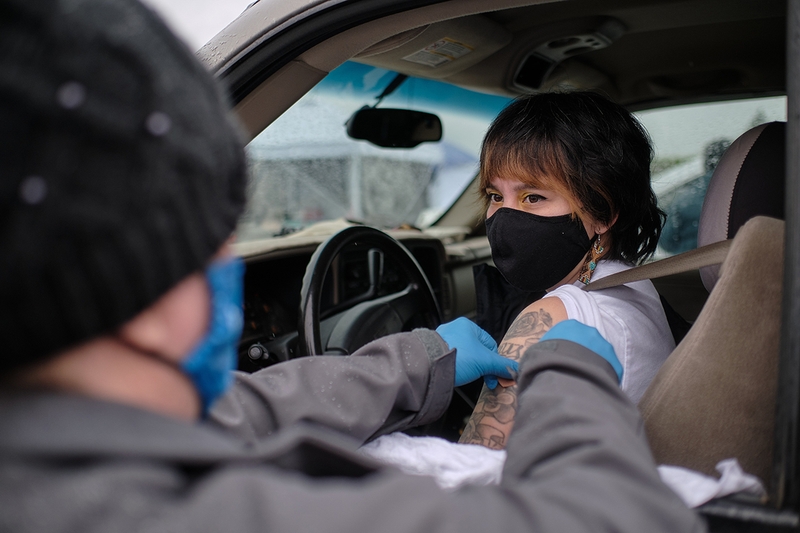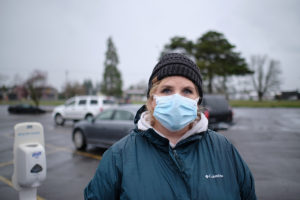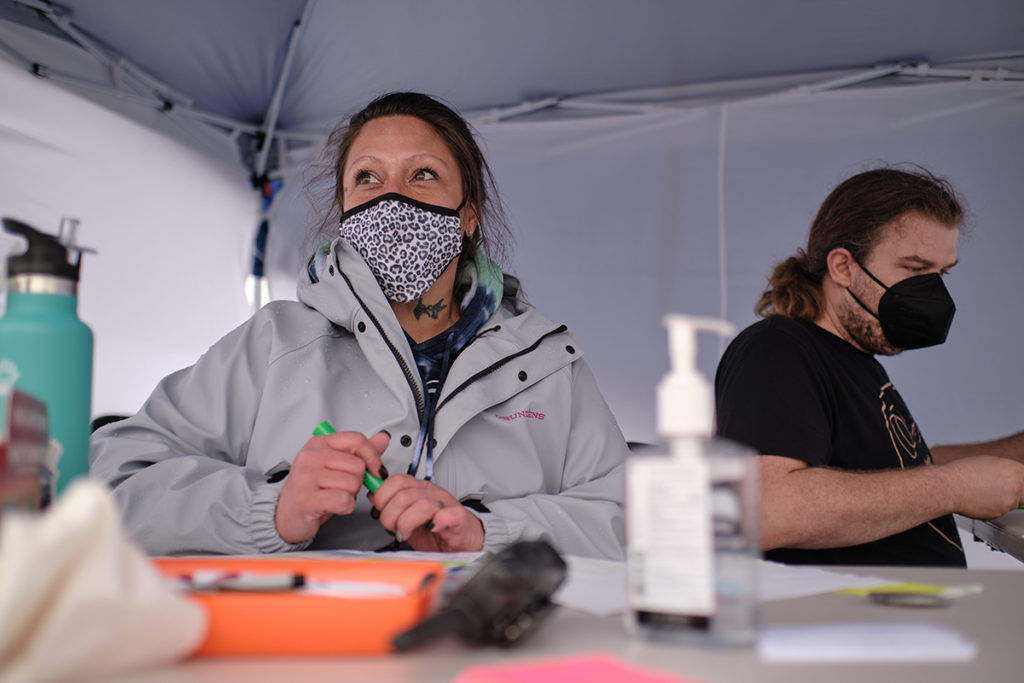
By BRIAN BULL/ Underscore.news
While the United States as a whole is just finding its stride administering the COVID-19 vaccine to its citizens, many Native American tribes – including the Confederated Tribes of Siletz Indians – are on a mean streak.
The Siletz tribe, based in Lincoln County, has vaccinated roughly one-quarter of the 5,547 enrolled members, and about one-third of those who live in Oregon, said Cherity Bloom-Miller, the tribe’s clinical services director. As of last week, the tribal government had given the Moderna vaccine to 3,000 people 18 and over, members and otherwise.
The Siletz has also agreed to begin calling non-tribal members on the Lincoln County Health Department’s waiting list – adding one more clinic and up to 500 doses to the growing number of vaccinations in the county.
Dee Pigsley, chairwoman of the Confederated Tribes of Siletz Indians, says she was concerned the initial vaccine rollout was moving too slowly. But by late January, they had enough Moderna vaccine allocated from the state for 300 people.
“So we’ve been setting up appointments for tribal members,” Pigsley continues, noting that the tribe was due to get another 100 doses the following week. “We’ve vaccinated the clinic staff, our essential staff, elders. So we’re working down that priority list.”
The Siletz are now inoculating workers at its Chinook Winds Casino Resort in Lincoln City, which has just reopened, boding well for one of the tribe’s biggest source of revenue.

The Oregon Health Authority says that as of March 9, 14,077 people identifying as American Indian or Alaska Native have been vaccinated against COVID-19, 2 percent of the 750,486 people vaccinated so far. According to the U.S. Census Bureau, 1.8 percent of Oregon’s 4 million residents identify as American Indian or Alaska Native.
A long history of mistreatment by the U.S. government, from chronic underfunding of the Indian Health Service to Native women being sterilized without their knowledge or consent, have understandably made tribal communities wary. Yet an Urban Indian Health Institute survey shows 75 percent of American Indians and Alaska Natives expressed a desire to get the COVID-19 vaccine (but with nearly 40 percent reporting having trouble getting to their clinics for the shot).
Tribal governments in Oregon have had success getting vaccines into arms through social media apps including Facebook and Nextdoor and through community word-of-mouth (which elders half-jokingly call the moccasin telegraph, more used to inform friends about powwows than about vaccine clinics, until recently.)
“In Oregon and the broader Northwest, it’s been very good for tribes,” says Bryan Mercier, Northwest regional director of the Bureau of Indian Affairs. He says tribes have strong social networks and have also leveraged existing resources such as Indian Health Service clinics to promote positive messaging about the COVID-19 vaccines.
“So what I’ve seen regionally, not just in Oregon, are tribes surpassing their state colleagues because of those infrastructures and networks,” Mercier says.
He recounted an example he shared at a recent Portland Indian Leaders Roundtable meeting in early February: “The Confederated Tribes of Umatilla Reservation in Mission had done something like 700 shots in arms. And the neighboring county had only done less than 10 at that time.”
The vaccines are provided to tribes through either the state of Oregon or the federal Indian Health Service. Once the vaccines are allocated, tribal officials can determine for themselves which groups will be prioritized outside what the state government decides.
Mercier says that after tribes have vaccinated the majority of their immediate members, they’ve opened up clinics to other Native Americans willing to travel. The Coquille Indian Tribe, Confederated Tribes of Grand Ronde, and Cowlitz Indian Tribe have done just that in recent weeks. The Coquille are also vaccinating relatives who share a home with an inoculated Indigenous person, such as spouses.
In cities, a different story
This might help in an area where Oregon has been less successful: getting vaccines to Native people who live in urban areas. This includes urban tribal members like 54-year-old Vikki Mata of Portland. Even before the heavy winter storms canceled many vaccine clinics and testing stations around Portland, Mata, a member of the Tlingit people, was struggling to find information about the shots.
“I’ve been doing a lot of research on what options are available to American Indians and Alaska Natives living in the greater metropolitan area,” Mata said. But she was unable to find clinics in Portland.
In contrast, she was hearing about vaccines available at tribal health centers in other parts of the state. Eventually, through social media apps including Facebook and Nextdoor, and by asking around, she learned that the Confederated Tribes of Grand Ronde were holding vaccination clinics across the state, including in Eugene and at the Chemawa Indian Health Center in Salem.
“I learned about other clinics because a friend saw my post on Facebook and messaged me,” adds Mata. “He is also American Indian. He’d driven out to Pendleton to get his. One of his motivations was that he’d lost his mother to COVID-19.”
Mata says she’s still not yet vaccinated, but after recuperating from shoulder surgery, she’s hoping to get a shot this month.

Coquille tribe doing well
One of the star players in Oregon’s vaccine drive is the Coquille Indian Tribe.
Based in Coos Bay, the tribe has invested its casino revenues and grant money in a number of ventures well beyond its traditional territory. In January, the Coquille began operating an outpatient health clinic in Eugene. With a $900,000 Indian Community Development Block grant, a basement space has been transformed into a facility that serves an area where an estimated 6,000 Native Americans live.
Kelle Little, health and human services administrator for the Coquille, says the tribe has expanded its reach to clinics in Roseburg, Medford, and the Portland area. As of March 5, she estimates they’ve vaccinated more than 1,500 people, which exceeds tribal enrollment. This includes Coquille tribal members and employees, other Native Americans who’ve traveled to the Coquille’s clinics, and relatives who live with inoculated members such as spouses.
Little says the Coquille had vaccinated approximately 80 percent of its tribal elders and spouses 55 years of age or older who live in their primary service area and 50 percent of those living in Oregon.
Fueling a lot of this is a need to restore community and a sense of normalcy. Dee Pigsley’s elder sister, Donna Woods, died of a brain aneurysm just before Thanksgiving last year. But the coronavirus cast its omnipresent shadow over Woods’ funeral, as mourners paid respects.
“We belong to the Catholic Church in Keizer,” said Pigsley. “At the time it was 50 people inside the church, 50 in a different part of the church. And our family, when we have a service, it’s usually a couple hundred people. And you have to tell people they can’t come, because that’s the way it is. It’s been difficult.”
Responsibility to vaccinate
Dr. Thomas Weiser, medical epidemiologist for the Portland Area Indian Health Service, said the federal government has a duty, based on treaties signed with Native American tribes, to ensure rapid vaccinations. IHS has been working on COVID-19 response with 23 of 43 Pacific Northwest tribes across Oregon, Washington, and Idaho since the pandemic hit a year ago.
“It’s really that federal trust responsibility that we have to make sure that tribes are provided with the resources that they need to care for their people, and that’s what we do,” Weiser says.
Another urgency has been protecting elders.
“We’ve been really worried, especially with really small tribes that maybe have fewer than a thousand members, if the critical culture bearers are not there to carry that culture forward, that so much could be lost,” he said. “So I think that is driving a lot of the tribes to make sure they’re protecting each other, not just through vaccinations but through all the things we do to minimize the spread of COVID in communities.”
Far from any services
Perhaps those having the hardest time accessing the vaccines are those living beyond the reservation and the city. Along the Columbia River are traditional village sites that members of the Yakama, Umatilla, Warm Springs, Nez Perce, and other tribes have shared for generations, largely for fishing. The lack of modern infrastructure limits communication and pandemic protocols considerably, as the federal government has yet to rebuild fully the original sites flooded by dam development back in the 1950s.
“The only running water are in the bathroom facilities, those with bathroom facilities,” says Jeremy FiveCrows, of the Columbia River Inter-Tribal Fish Commission. “Others are just pit toilets. People just pull in trailers, tents, tipis, vans, RVs. It’s such an easy situation for COVID to spread, because it’s not like people can be like, ‘Oh, I’ll just quarantine here.’ You still need to use the bathroom or take a shower, where everybody uses the same place.”
CRITFC applied for grants through the Oregon Community Foundation, and with One Community Health based in The Dalles and Hood River area, received a specialized medical van for testing and vaccination for the Native people living in the basin area.
“It’s a lot of effort to get if you’re 200-300 miles from your reservation,” says FiveCrows. He says their first venture was in January at the Celilo Village site. In less than a day, all 100 doses were accounted for, something he attributes to a “brute force” outreach campaign with partner The Next Door.
“They went from site to site, just knocked on doors or campers and told them, ‘If you’re in these age groups, you’re eligible. Can we sign you up?’” FiveCrows said. “It took a lot of effort to get the success that they did.”
He says there are already two other mobile clinics planned for the village sites, and he credits the higher interest among Native Americans in getting the needle in the arm for that success.
“You also wonder how much of that is from the cultural memory of how different pandemics swept through the tribal populations and decimated us,” FiveCrows said. “So how much of that played into trying to fight that, knowing we probably have grandparents or parents that may have died from other pandemics?”
- This story originally appeared on Underscore.news. Underscore is a nonprofit collaborative reporting team in Portland focused on investigative reporting and Indian Country coverage. We are supported by foundations, corporate sponsors and donor contributions. Follow Underscore on Facebook and Twitter.


